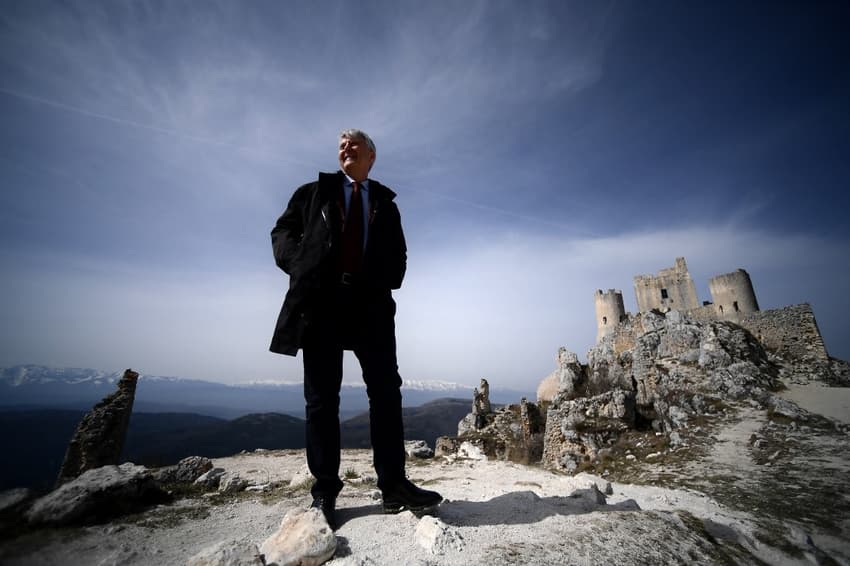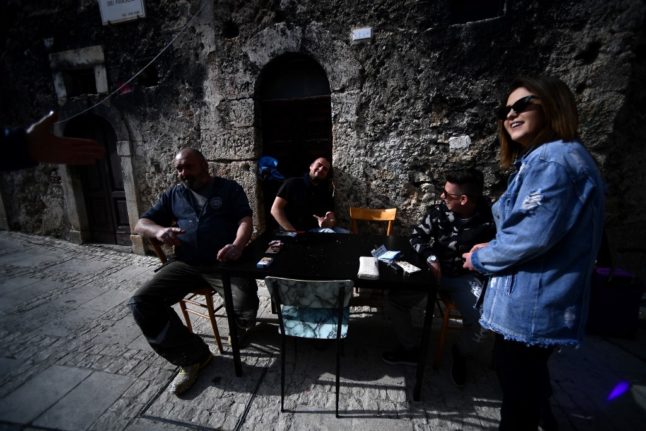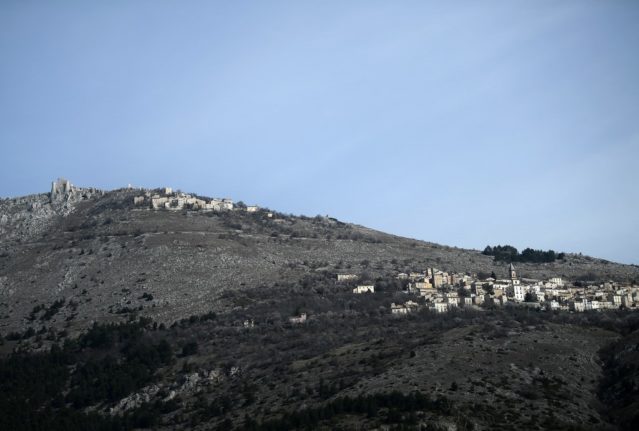How one dying Italian village plans to spend €20m in EU recovery funds

The depopulated hamlet of Calascio in Abruzzo, with just 130 residents and an earthquake-damaged castle, is preparing for a multimillion-euro revival based on tourism, sheep farming, and an unusual local cheese.
The streets are silent and cats hunt in abandoned houses, but the view from the battlements of Calascio's castle is spectacular - good enough perhaps to save this dying Italian hamlet.
Local officials have put restoring the ruins and attracting tourists at the heart of their bid to revive the village, which has won 20 million euros ($22 million) in EU post-pandemic funds.
Surrounded by Abruzzo's snowcapped peaks, Calascio is one of 21 dying or deserted villages recently awarded an equal share of a 420-million-euro fund from the Italian government.
Critics question how equipped the tiny councils are to spend such vast sums of money - which translates to almost 154,000 euros per person in underpopulated Calascio.
The nationwide project has soured relations in several regions between winning villages and those that have lost out, and prompted warnings over potential fraud and waste.

The castle of Calascio on March 29, 2022. Photo by GIOVANNI GREZZI / AFP
But Calascio's mayor Paolo Baldi, a former mountain guide originally from Rome, is undaunted.
"We want to bring the hamlet back to life," said Baldi, who did up one of its ruined houses in 1993 and moved in with his young family.
READ ALSO: The Italian towns launching alternatives to one-euro homes
Once a bustling and wealthy wool-producing town, Calascio shrunk from over 2,000 residents at the start of the 1900s to just 130 now, almost all of them elderly. In the winter months, only 70 or so people remain.
Just three children have been born here in 12 years. The hamlet has no grocer's shops, school or doctor's surgery.
What the hamlet does have is Rocca Calascio, an ancient castle which draws 100,000 tourists a year.
Baldi plans to spend a big chunk of the funds - just over 4.6 million euros - on restoring part of the ruins, which were damaged in a deadly earthquake in 2009.

A family sits at a table by the entrance to their house in Calascio. Photo by FILIPPO MONTEFORTE / AFP
It is hoped archaeological digs will determine when the castle was built, and reveal more about a neighbouring church and graveyard, where bones come to the surface after storms.
Some funds will also go to creating jobs and attracting tourists, with just under 7.5 million euros earmarked for participation in the alberghi diffuci project - creating a "scattered" hotel, with accommodation in the village's empty houses - and nearly one million euros for a museum.
Locals say they hope young families will move in to the area and perhaps open their own businesses.
"Do you know what the biggest event was in Calascio this year? It was the birth of a baby," tobacconist Walter Zara told AFP.

People walk in the village of Rocca Calascio. Photo by FILIPPO MONTEFORTE / AFP
Italy is the biggest beneficiary of the EU's 800-billion-euro plan to boost the bloc after the pandemic, allocated almost 200 billion euros in grants and loans.
The funds for Calascio are part of a programme to increase tourism in undervalued areas, notably in the poorer south, and ease pressure on hotspots like Venice.
Villages across Italy competed, with winners including Pietrabbondante in Molise, which boasts a sixth-century amphitheatre.
READ ALSO:
- Will Italy really pay you to move to its ‘smart working’ villages?
- Digital divide: The parts of Italy still waiting for fast wifi
- The ups and downs of buying a property for retirement in a hilltop town
"Italy's real wealth today lies precisely in these small centres," Mayor Baldi says, adding that countless hilltop hamlets across the country are in a state of serious decline but could be "a driving force for the economy"
Here, that driving force includes a sheep farming school. The plan is to teach youngsters the ancient art of pastoralism, where shepherds and their flocks spend the warmer months on the move.
Funds will also go to increasing cheese production. The region's pride is Marcetto, a traditional sheep's cheese made using live maggots, which soften it with their digestive acids.

The village of Calascio (R) and Rocca Calascio (Top L) with its castle on March 29, 2022. Photo by FILIPPO MONTEFORTE / AFP
It was staple for herders who used to gather with their flocks outside the 16th-century Santa Maria della Pieta church, perched just along the ridge from the castle.
Bleating livestock permitting, mass at the so-called "Shepherds' Church" was followed through a little side window.
Fermented cheese and religion may not be enough. Domenico Ciccone, 78, who began shepherding at just 10 years old, said he was not convinced it was a job that would attract many youngsters.
Ciccone's son and wife pitch in with the milking, but without a new generation of pastoralists to help over the coming summer, he has been forced to sell much of his flock
"It's a tough job, you've got to like it. There's no taking time off for a party, or a Sunday, (or) if it's stormy".
He also questions whether training new shepherds will help reverse the population decline, quipping that "a 20-year-old who looks after sheep all day long isn't going to have any luck with women!"
By AFP's Ella Ide
Comments
See Also
The streets are silent and cats hunt in abandoned houses, but the view from the battlements of Calascio's castle is spectacular - good enough perhaps to save this dying Italian hamlet.
Local officials have put restoring the ruins and attracting tourists at the heart of their bid to revive the village, which has won 20 million euros ($22 million) in EU post-pandemic funds.
Surrounded by Abruzzo's snowcapped peaks, Calascio is one of 21 dying or deserted villages recently awarded an equal share of a 420-million-euro fund from the Italian government.
Critics question how equipped the tiny councils are to spend such vast sums of money - which translates to almost 154,000 euros per person in underpopulated Calascio.
The nationwide project has soured relations in several regions between winning villages and those that have lost out, and prompted warnings over potential fraud and waste.

But Calascio's mayor Paolo Baldi, a former mountain guide originally from Rome, is undaunted.
"We want to bring the hamlet back to life," said Baldi, who did up one of its ruined houses in 1993 and moved in with his young family.
READ ALSO: The Italian towns launching alternatives to one-euro homes
Once a bustling and wealthy wool-producing town, Calascio shrunk from over 2,000 residents at the start of the 1900s to just 130 now, almost all of them elderly. In the winter months, only 70 or so people remain.
Just three children have been born here in 12 years. The hamlet has no grocer's shops, school or doctor's surgery.
What the hamlet does have is Rocca Calascio, an ancient castle which draws 100,000 tourists a year.
Baldi plans to spend a big chunk of the funds - just over 4.6 million euros - on restoring part of the ruins, which were damaged in a deadly earthquake in 2009.

It is hoped archaeological digs will determine when the castle was built, and reveal more about a neighbouring church and graveyard, where bones come to the surface after storms.
Some funds will also go to creating jobs and attracting tourists, with just under 7.5 million euros earmarked for participation in the alberghi diffuci project - creating a "scattered" hotel, with accommodation in the village's empty houses - and nearly one million euros for a museum.
Locals say they hope young families will move in to the area and perhaps open their own businesses.
"Do you know what the biggest event was in Calascio this year? It was the birth of a baby," tobacconist Walter Zara told AFP.

Italy is the biggest beneficiary of the EU's 800-billion-euro plan to boost the bloc after the pandemic, allocated almost 200 billion euros in grants and loans.
The funds for Calascio are part of a programme to increase tourism in undervalued areas, notably in the poorer south, and ease pressure on hotspots like Venice.
Villages across Italy competed, with winners including Pietrabbondante in Molise, which boasts a sixth-century amphitheatre.
READ ALSO:
- Will Italy really pay you to move to its ‘smart working’ villages?
- Digital divide: The parts of Italy still waiting for fast wifi
- The ups and downs of buying a property for retirement in a hilltop town
"Italy's real wealth today lies precisely in these small centres," Mayor Baldi says, adding that countless hilltop hamlets across the country are in a state of serious decline but could be "a driving force for the economy"
Here, that driving force includes a sheep farming school. The plan is to teach youngsters the ancient art of pastoralism, where shepherds and their flocks spend the warmer months on the move.
Funds will also go to increasing cheese production. The region's pride is Marcetto, a traditional sheep's cheese made using live maggots, which soften it with their digestive acids.

It was staple for herders who used to gather with their flocks outside the 16th-century Santa Maria della Pieta church, perched just along the ridge from the castle.
Bleating livestock permitting, mass at the so-called "Shepherds' Church" was followed through a little side window.
Fermented cheese and religion may not be enough. Domenico Ciccone, 78, who began shepherding at just 10 years old, said he was not convinced it was a job that would attract many youngsters.
Ciccone's son and wife pitch in with the milking, but without a new generation of pastoralists to help over the coming summer, he has been forced to sell much of his flock
"It's a tough job, you've got to like it. There's no taking time off for a party, or a Sunday, (or) if it's stormy".
He also questions whether training new shepherds will help reverse the population decline, quipping that "a 20-year-old who looks after sheep all day long isn't going to have any luck with women!"
By AFP's Ella Ide
Join the conversation in our comments section below. Share your own views and experience and if you have a question or suggestion for our journalists then email us at [email protected].
Please keep comments civil, constructive and on topic – and make sure to read our terms of use before getting involved.
Please log in here to leave a comment.